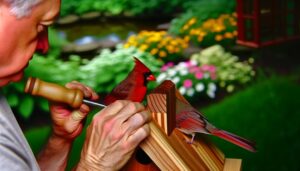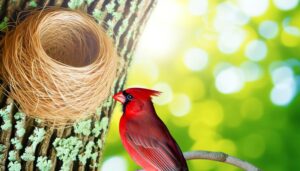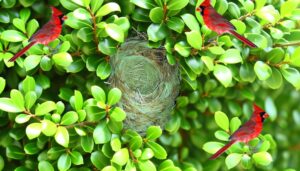7 Tips from Stan Tekiela to Attract and Feed Cardinals
To attract cardinals, understand their diurnal activity peaks and territorial behaviors. Place sturdy feeders made of metal or UV-stabilized plastic near dense shrubs or trees.
Fill feeders with high-oil seeds like black-oil sunflower seeds and safflower seeds. Provide crushed peanuts and mealworms for added nutrition, especially during breeding season.
Set up bird baths with shallow basins in shaded areas, replacing water regularly. Create a cardinal-friendly habitat with thick shrubbery and native trees like dogwoods and oaks.
Protect from predators by elevating feeders and planting dense vegetation. Now, get ready to observe these vibrant birds in your sanctuary.
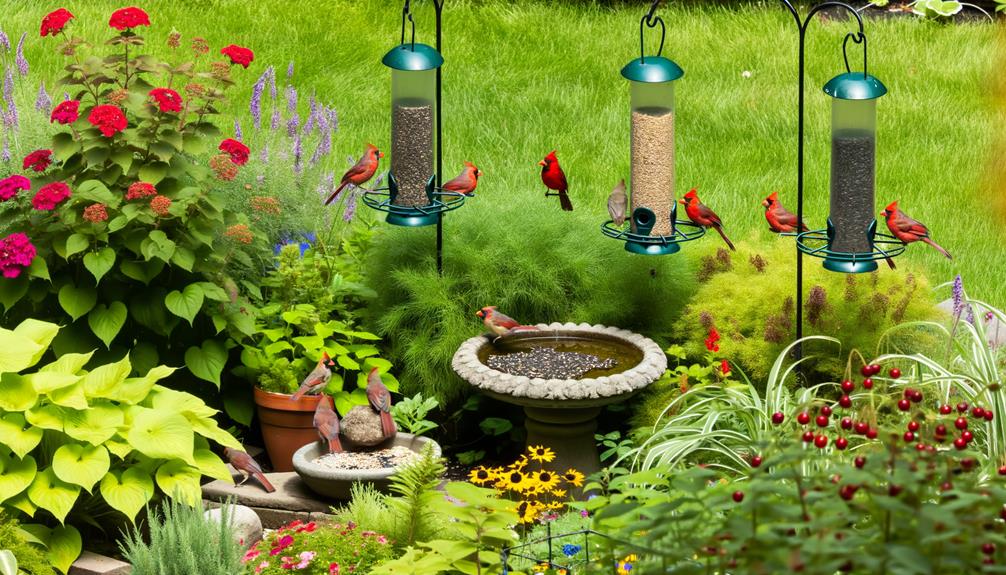
Key Takeaways
- Offer black-oil sunflower seeds and safflower seeds to attract cardinals.
- Place feeders near dense shrubs or trees for security and easy access.
- Use sturdy, squirrel-proof feeders to protect the food supply.
- Provide fresh water in a shallow basin and maintain cleanliness.
- Plant indigenous trees and shrubs to create a cardinal-friendly habitat.
Understanding Cardinal Behavior
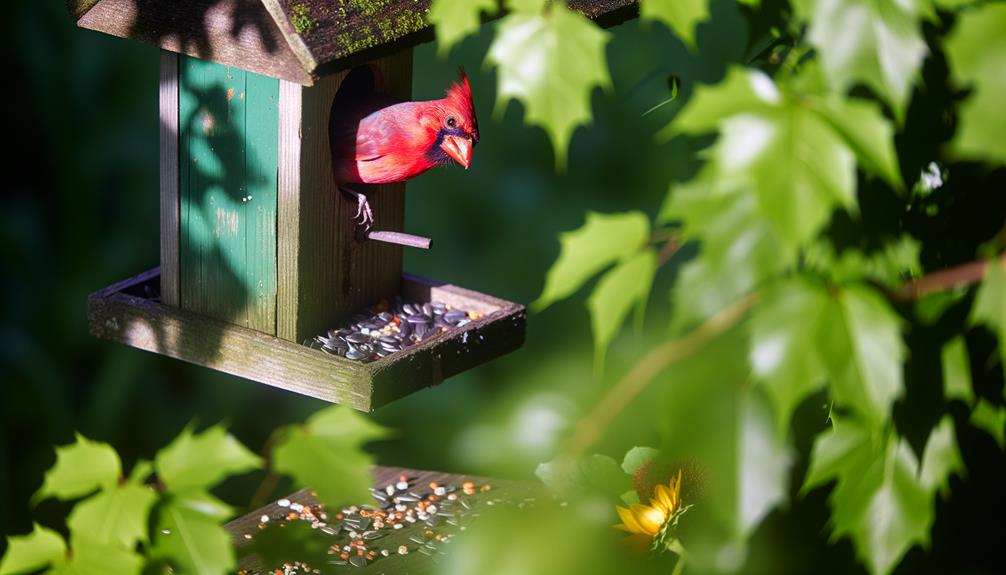
To attract cardinals effectively, understanding their diurnal activity patterns and territorial behaviors is essential. Cardinals are diurnal, meaning they're most active during daylight hours, particularly during early morning and late afternoon. Observing these patterns helps you know the best times to offer food.
Cardinals exhibit strong territorial instincts; males often defend their territory aggressively, especially during breeding season. They communicate through distinct vocalizations, which serve both territorial and mating purposes. By recognizing these behaviors, you can tailor your approach to attract them more consistently.
Incorporate natural elements like dense shrubs and trees, which cardinals prefer for nesting and perching. Their preference for specific habitats and their predictable activity cycles provide valuable insights for attracting these vibrant birds to your space.
Choosing the Right Bird Feeder
Selecting the right bird feeder is essential for attracting cardinals. Considering feeder material options, it is best to choose feeders made of sturdy materials like metal or UV-stabilized plastic to withstand weather conditions and prevent wear.
Placement of the feeder is crucial. It should be placed in a peaceful, elevated area, ideally 5-6 feet off the ground, to deter predators. Using squirrel baffles or weight-sensitive mechanisms can help keep out unwanted pests.
Feeder Material Options
When choosing the right bird feeder, materials like metal, wood, and plastic each offer distinct advantages and disadvantages that can greatly impact the health and feeding behavior of cardinals.
Metal feeders are durable and resistant to squirrel damage but can get very hot in direct sunlight.
Wooden feeders provide a natural look and good insulation but can harbor mold if not cleaned regularly.
Plastic feeders are lightweight and easy to clean, though they may become brittle over time.
Consider these points:
- Durability: Metal lasts longer but heats up; plastic is lightweight but can degrade.
- Maintenance: Wood needs frequent cleaning; plastic is easier to maintain.
- Environmental Impact: Wood is biodegradable; plastic and metal are not.
Choose wisely to support cardinals' well-being.
Optimal Feeder Placement
Placing your feeder in a quiet, sheltered spot near dense shrubbery or trees provides cardinals with a sense of security and easy access to cover from predators. Cardinals prefer feeding in environments where they can quickly retreat to safety. Observations show that feeders positioned 10-15 feet from cover are ideal. This distance is close enough for protection yet far enough to prevent ambushes from predators lurking in the foliage.
Utilize feeders with a sturdy perch and ample feeding ports. Opt for a feeder height ranging between 5-6 feet to accommodate their natural feeding behaviors. Evidence suggests that feeders placed in open, visible areas attract fewer cardinals, as these birds prioritize safety and seclusion.
Squirrel-Proof Features
To effectively deter squirrels while attracting cardinals, choose bird feeders equipped with weight-sensitive mechanisms and chew-resistant materials. These features guarantee that only birds of appropriate size can access the feed, maintaining a consistent food supply for cardinals. Squirrels, being heavier, will trigger the closing mechanism, safeguarding the seed.
Here's what to look for:
- Weight-Sensitive Perches: Adjust to close under a squirrel's weight, ensuring cardinals can feed undisturbed.
- Chew-Resistant Materials: Utilize metal or durable plastic to prevent squirrels from gnawing through.
- Baffle Systems: Install above or below feeders to obstruct squirrels' climbing routes.
Best Foods for Cardinals
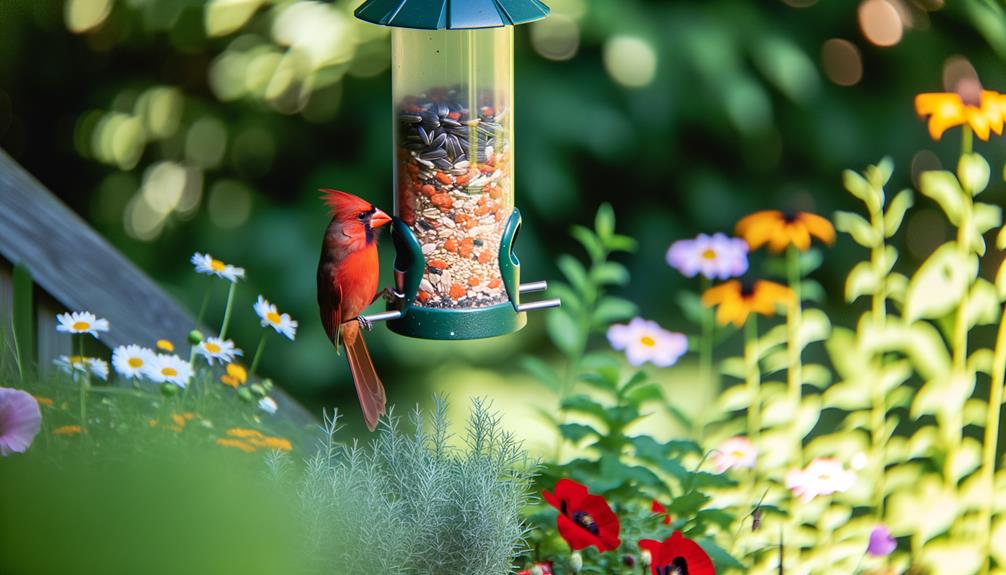
Curious about what to feed cardinals? These vibrant birds thrive on a diet rich in high-oil seeds. Black-oil sunflower seeds are a cardinal favorite due to their thin shells and high-fat content, providing essential energy.
Safflower seeds are another excellent choice; their hard shells deter other birds, leaving more for the cardinals. Incorporate crushed peanuts and cracked corn for added variety and nutritional balance. Scientific studies show that these foods mimic the cardinals' natural foraging habits and optimize their health.
You can also include mealworms for protein, especially during breeding seasons. Always choose fresh, high-quality seeds and avoid fillers like milo or wheat, as they offer little nutritional value and are often discarded by cardinals.
Providing Fresh Water
You should set up bird baths with shallow basins and textured surfaces to facilitate easy access and prevent slipping.
Regularly replace the water to inhibit algae growth and reduce the risk of waterborne pathogens.
Monitoring the water quality guarantees cardinals can hydrate safely, thereby supporting their overall health and well-being.
Bird Baths Setup
Installing a bird bath with clean, fresh water plays a crucial role in attracting cardinals and maintaining their hydration. Position your bird bath in a shaded area to prevent water evaporation and algae growth. Cardinals prefer baths that are slightly elevated and away from dense foliage to avoid predators.
Here are three essential steps for an effective bird bath setup:
- Choose a shallow basin: Make sure the depth is no more than 2 inches to accommodate the cardinals' bathing preferences.
- Add a textured surface: Use a rough basin or add stones to provide grip, preventing slips.
- Ensure stability: Place the bath on a leveled surface to avoid tipping.
Water Quality Maintenance
Maintaining water quality in your bird bath is crucial for attracting cardinals and ensuring their health. Change the water every two days to prevent algae growth and bacterial contamination.
Clean the bird bath weekly using a 9:1 water-to-bleach solution—rinse thoroughly to remove any residual chemicals.
Position the bird bath in a shaded area to minimize evaporation and keep the water cooler.
Use a water heater in winter to prevent freezing, ensuring cardinals have access year-round.
Observational studies indicate that cardinals frequent clean water sources more often, enhancing your chances of attracting them.
Creating a Cardinal-Friendly Habitat
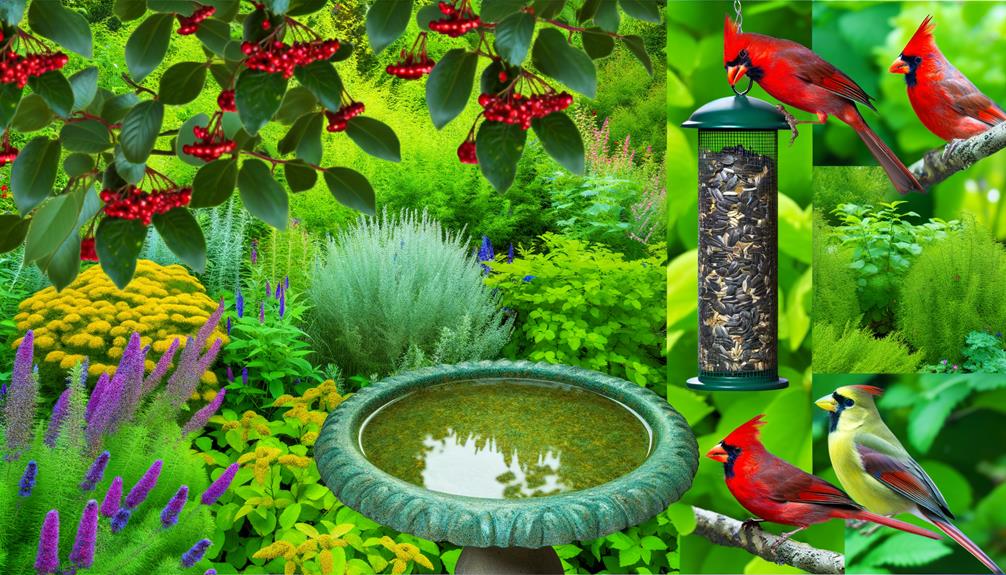
To create a cardinal-friendly habitat, make sure the area includes thick shrubbery and indigenous trees that offer both shelter and nesting opportunities. Cardinals prefer habitats that mimic their natural environments.
Enhance your yard by incorporating:
- Thick Vegetation: Cardinals thrive in thickets and tangles of dense shrubs like dogwood or juniper.
- Indigenous Trees: Planting oaks or maples provides essential nesting sites and food sources.
- Ground Cover: Leaf litter and low-lying plants offer additional foraging areas.
Scientific studies show cardinals exhibit site fidelity, frequently returning to the same area if conditions remain favorable. Ensure water sources are nearby and avoid excessive pesticide use to maintain a healthy insect population.
Seasonal Feeding Tips
Providing the right food throughout the year enhances the cardinal-friendly habitat you've created, ensuring these vibrant birds have the nutrients they need during different seasons.
In winter, offer high-fat seeds like black oil sunflower and safflower seeds to help cardinals maintain their energy levels.
Spring brings breeding season, so supplement their diet with mealworms and suet to support their increased nutritional needs.
During summer, fresh fruit such as berries can provide essential vitamins, aiding in molting.
Autumn calls for a return to high-fat seeds to prepare cardinals for the colder months ahead.
Regularly clean feeders to prevent mold and disease, ensuring a healthy feeding environment year-round.
Observing these tips will create a thriving ecosystem for your cardinal visitors.
Protecting Cardinals From Predators
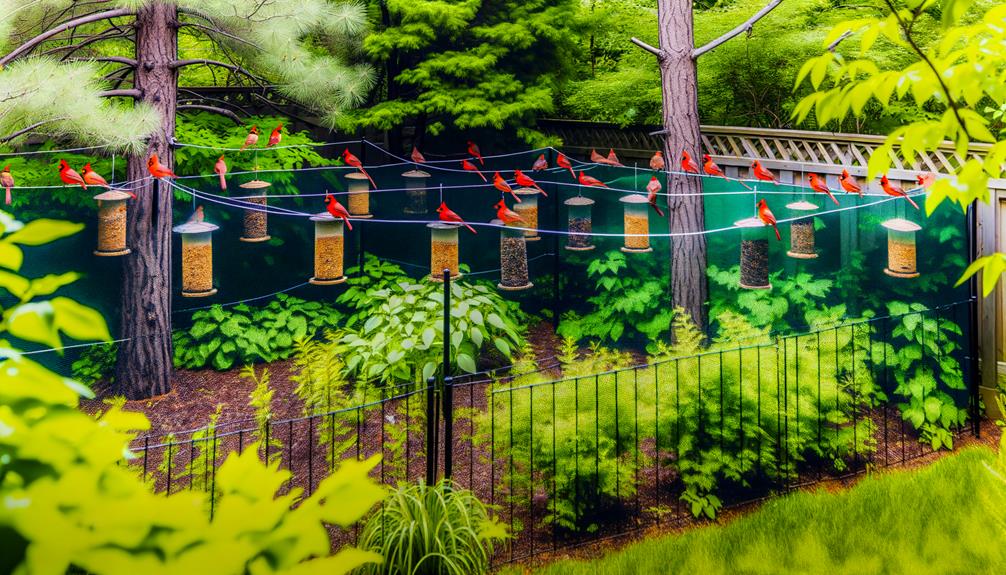
Ensuring the safety of cardinals from predators involves strategic feeder placement and habitat design, taking into account their natural behaviors and vulnerabilities. Cardinals prefer dense shrubbery for cover, so placing feeders near these areas can provide immediate refuge. Avoid open spaces where predators can easily spot and ambush them.
Consider these three strategies:
- Elevate Feeders: Position feeders at least 5-6 feet off the ground to deter ground predators.
- Install Baffles: Use predator baffles on feeder poles to prevent climbing predators like squirrels and raccoons.
- Dense Vegetation: Plant thick bushes and trees nearby, giving cardinals quick access to shelter.
These tactics create a safe environment, reducing predation risks and allowing cardinals to thrive.
Cardinal Nesting Preferences
Understanding cardinal nesting preferences requires observing their inclination for choosing spots that offer seclusion and protection, much like their feeding areas. You'll find that cardinals favor dense shrubbery or thickets, which provide ample coverage from predators and harsh weather. They often select nesting sites that are between 3 to 10 feet above ground. Look for them in trees with dense foliage or evergreen shrubs.
Cardinals use twigs, leaves, and grass to construct their nests, ensuring a sturdy yet hidden sanctuary. Female cardinals typically build the nest while males supply materials, a behavior known as biparental care.
Studies show they prefer habitats with a mix of open and wooded areas, offering both foraging opportunities and secure nesting sites.
Observing and Enjoying Cardinals
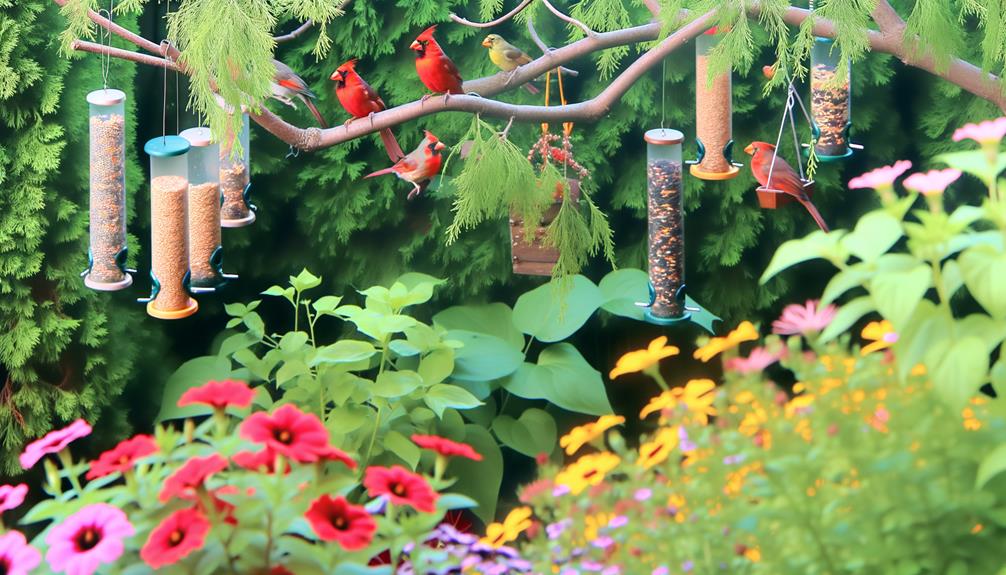
When observing cardinals, you'll notice their vibrant plumage and distinct calls, which make them a delightful subject for birdwatchers and researchers alike. Their bright red feathers are a striking example of sexual dimorphism, where males display more vivid colors to attract mates.
Pay attention to their melodic chirps and whistles, which serve as both communication and territorial signals.
To maximize your cardinal-watching experience, consider these tips:
- Timing: Early morning and late afternoon are the best times to observe active cardinals.
- Location: Cardinals prefer dense shrubs and trees, so position yourself near such vegetation.
- Tools: Use binoculars and a field guide to enhance your identification skills.
Embrace the freedom to explore nature's wonders with these beautiful birds.
Conclusion
By attracting and feeding cardinals, you create a vibrant, lively garden while supporting these beautiful birds. Picture a bright red male cardinal perched on a well-placed feeder, contrasting with the lush green foliage.
Your efforts in selecting the right foods and providing fresh water become critical lifelines, ensuring their survival against predators and harsh weather.
The science is clear: a carefully crafted habitat not only draws cardinals but also enriches your outdoor experience, making each sighting a rewarding event.


